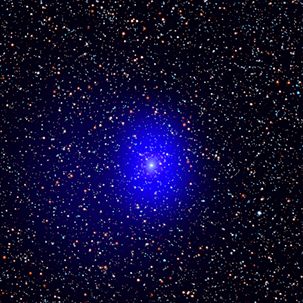Giant Black Hole Pair Photobombs Andromeda Galaxy

Professor Emily Levesque & Trevor Dorn-Wallenstein
Trevor is a third-year Astronomy graduate student at the University of Washington in Seattle, working with Professor Emily Levesque. He led the paper that is the subject of our latest press release on the discovery of a giant black hole pair that is photobombing the Andromeda Galaxy. He is interested in massive stars and young stellar populations, as well as playing the drums and baking cookies.
It’s funny how a simple case of mistaken identity can lead to the discovery of exotic objects hiding as unassuming dots in the sky.
My advisor, Professor Emily Levesque, and I, both astronomers at the University of Washington, were interested in finding star systems called red supergiant X-ray binaries. These systems consist of a compact object, like a neutron star or black hole, and a red supergiant — massive stars like Betelgeuse that are 10-20 times the mass of our sun but much less hot. Mass from the supergiant is lost to the compact object, where it should heat up and glow brightly in X-rays. While no such systems have been conclusively identified, red supergiant X-ray binaries could be used to better understand the evolution of the most extreme star systems.
As observational astronomers, we were faced with an interesting problem. Red supergiants are rare, and such an exotic system should be incredibly difficult to find. So how do we look for them? To conclusively identify such a system would require a spectrum — a measurement of how much light is being emitted as a function of wavelength — but deciding which objects to dedicate hours of telescope time into requires thought. To develop a short list of candidates, we looked for objects that were bright, red, and glowed in X-rays. None of the known red supergiants in our galaxy were X-ray sources, so we turned to the Andromeda galaxy, a.k.a. M31, which is close enough for us to resolve individual stars, including hundreds of likely red supergiants.
Cross-matching these stars with known X-ray sources observed by the Chandra X-ray Observatory revealed one close match: LGGS J004527.30+413254.3 — J0045+41 for short — and an X-ray source, CXO J004527.3+413255. Previous work on J0045+41 had found evidence that it varied periodically, a good indicator that it was potentially a binary. We were convinced, and decided to get a follow-up spectrum of J0045+41 using the Gemini North telescope.
As soon as the data came in, I began the long alchemy of extracting our spectrum from the raw data. What would we see? I ran through a mental checklist of all the things that could satisfy our basic search criteria. One possibility was an active galactic nucleus (AGN): a supermassive black hole at the center of a galaxy, pulling matter inwards and glowing in X-rays.
When the spectrum was ready, I sent it to Professor Levesque. Her response: “I think it’s good news/bad news…” The bad news was that J0045+41 had the classic hallmarks of an AGN: broad emission lines from ionized hydrogen, small features corresponding to gas in its host galaxy, all “redshifted” due to the expansion of space between us and J0045+41. The intrinsic brightness, distance away from us (some three billion light years away), and X-ray signature of J0045+41, all conspired to fool us.

J0045+41 in M31
The good news? “...if it is [an AGN] it’s, at least to my eye, a pretty weird one worth exploring!” J0045+41 wasn’t just red… it was far redder than many AGN. The spectrum showed that most of the light was coming from J0045+41’s host galaxy. Not only that: the spectral features from the AGN itself were bluer than those from the galaxy, which implies this AGN was actually moving towards us relative to the host galaxy! The final oddity was the previously-reported periodic variability. AGNs flicker randomly as their black holes swallow matter; there should be no discernable pattern.
To investigate, we brought on an AGN variability expert, Dr. John Ruan, a fellow UW graduate student who is now a Postdoctoral fellow at McGill University. Together we turned to data from the Palomar Transient Factory (PTF, currently being upgraded to the Zwicky Transient Facility). We then ran a test: if we simulate data from 100,000 randomly flickering AGN identical to J0045+41, are there any signals in the data on J0045+41 that we couldn’t find in the simulations?
To our surprise, we found not just one, but multiple signals. Most interestingly, two of them had periods of 82 and 328 days — a 1:4 ratio. What could be causing this? Dr. Ruan had the explanation: J0045+41 could be a supermassive black hole binary (SMBHB). When two supermassive black holes orbit each other, they can stir up eddies and gaps in the accretion disk around them. These perturbations can generate multiple periodic signals from the system in the exact ratio we found in J0045+41. If one of the black holes was moving towards us in its orbit when we observed our spectrum, the Doppler effect would cause a blueshift exactly like what we saw.
Of course there are many things besides SMBHBs that can generate similar signals! But if it is a SMBHB, it’s an incredibly interesting one. J0045+41 is the first candidate SMBHB with multiple periods in the exact ratio predicted by theory. It’s also the candidate with the closest predicted orbital separation. While it’s hard to determine the separation of the black holes from the observed periods, we think that the black holes could be orbiting only a few tens of light hours apart! This is so close that the system would be emitting gravitational radiation, and they could merge within the next few thousands/tens of thousands of years, depending on our assumptions about the masses of the individual black holes.
Like all discoveries, this will require careful consideration and confirmation by independent teams of researchers. But if confirmed, J0045+41 would represent an incredibly exciting and exotic system. This is one of my favorite things about doing science: the possibility of unexpected discovery hidden in plain sight.
A paper describing this result was accepted for publication in The Astrophysical Journal and a preprint is available online.
For more information, visit: https://chandra.harvard.edu/photo/2017/m31/
